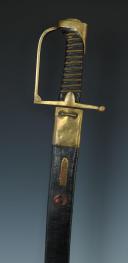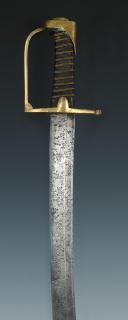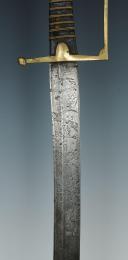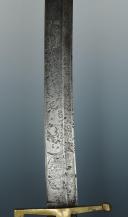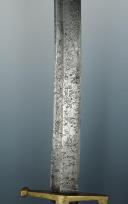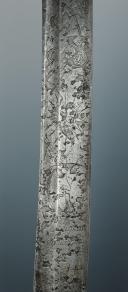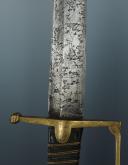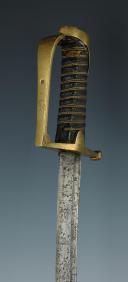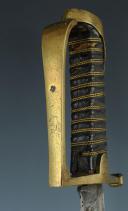
Louis XVI boarding saber, old monarchy-revolution.
Sold out
BOARDING SWORD LOUIS XVI, OLD MONARCHY-REVOLUTION.
Brass hilt, guard with one branch marked with a rooster (a hallmark for revolutionary productions from 1793 onwards), state agents' hallmark, and a marine anchor surmounted by a revolutionary cap. Cap with a short tail, handle made of wood covered with filigree brass veal. Short blade with a wide back and grooves, length 52.5 cm, width at the heel 3.6 cm. Engraved on the first third with a moon, a sun, and an armed right arm coming out of a cloud, and engraved near the heel "Cassaignard supplier of the king in Nantes" (the word king has been filed off). Cowhide leather scabbard with two brass fittings and a brass plate formerly glued on the leather, engraved "BOARDING SWORD LOUIS XVI."
Very good condition, strong oxidation on the blade, rear seam of the scabbard partially unsewn.
France.
Old Monarchy.
NOTE:
Michel Pétard in his work "The Boarding Sword" (Editions du Canonnier 2006) studies this sword on pages 62-63, figures 104 to 116. He dates it to the period 1790 to 1795 and states:
"Cassagnard, an "arquebusier-supplier" running a shop near the Bourse in Nantes, under the signs "A la Victoire" then "A l'hindoue," naturally directed his production toward the privateering or merchant navy as did many of his colleagues established in the great ports of the kingdom. The revolutionary State placed significant orders with him for white arms intended for its navy, and although no archive has been found, sabres have survived, and the rooster hallmark struck on the mounts demonstrates these official supplies from 1793, even though they began before the proclamation of the Republic, as evidenced by blades signed "Cassaignard, Supplier of the King in Nantes." Subsequently, arms already manufactured at this date saw the word "King" mutilated before disappearing in later orders. Brass hilt marked with the rooster by State agents, sometimes also with the name or initial of the founder "MIDLOT" or 'J'. Square wooden handle sheathed in veal and filigreed with brass, and cap. Short blade with a back and wide grooves of varying lengths: 47-52-59 or 65 cm with a 4 cm heel and approximately 1.4 cm of arrow. This type of blade - of mediocre forge - is an exclusivity of the Nantes supplier, at least in France, and likely originates from a Solingen workshop as indicated by the engraved symbols, dear to this armory center, but one cannot exclude a production from Saint-Étienne that reused these decorations. Recall that suppliers market white arms whose blades exclusively come from specialized workshops. Natural cowhide leather scabbard, edged and channeled, with brass fittings: a chape with a 7 cm button and a tip of 9.5 cm. Weight of the weapon without scabbard: 720 to 790 grams. Identical blades can be found on mounts of very rustic foreign style, probably reserved for privateering or merchant navy armaments."
Brass hilt, guard with one branch marked with a rooster (a hallmark for revolutionary productions from 1793 onwards), state agents' hallmark, and a marine anchor surmounted by a revolutionary cap. Cap with a short tail, handle made of wood covered with filigree brass veal. Short blade with a wide back and grooves, length 52.5 cm, width at the heel 3.6 cm. Engraved on the first third with a moon, a sun, and an armed right arm coming out of a cloud, and engraved near the heel "Cassaignard supplier of the king in Nantes" (the word king has been filed off). Cowhide leather scabbard with two brass fittings and a brass plate formerly glued on the leather, engraved "BOARDING SWORD LOUIS XVI."
Very good condition, strong oxidation on the blade, rear seam of the scabbard partially unsewn.
France.
Old Monarchy.
NOTE:
Michel Pétard in his work "The Boarding Sword" (Editions du Canonnier 2006) studies this sword on pages 62-63, figures 104 to 116. He dates it to the period 1790 to 1795 and states:
"Cassagnard, an "arquebusier-supplier" running a shop near the Bourse in Nantes, under the signs "A la Victoire" then "A l'hindoue," naturally directed his production toward the privateering or merchant navy as did many of his colleagues established in the great ports of the kingdom. The revolutionary State placed significant orders with him for white arms intended for its navy, and although no archive has been found, sabres have survived, and the rooster hallmark struck on the mounts demonstrates these official supplies from 1793, even though they began before the proclamation of the Republic, as evidenced by blades signed "Cassaignard, Supplier of the King in Nantes." Subsequently, arms already manufactured at this date saw the word "King" mutilated before disappearing in later orders. Brass hilt marked with the rooster by State agents, sometimes also with the name or initial of the founder "MIDLOT" or 'J'. Square wooden handle sheathed in veal and filigreed with brass, and cap. Short blade with a back and wide grooves of varying lengths: 47-52-59 or 65 cm with a 4 cm heel and approximately 1.4 cm of arrow. This type of blade - of mediocre forge - is an exclusivity of the Nantes supplier, at least in France, and likely originates from a Solingen workshop as indicated by the engraved symbols, dear to this armory center, but one cannot exclude a production from Saint-Étienne that reused these decorations. Recall that suppliers market white arms whose blades exclusively come from specialized workshops. Natural cowhide leather scabbard, edged and channeled, with brass fittings: a chape with a 7 cm button and a tip of 9.5 cm. Weight of the weapon without scabbard: 720 to 790 grams. Identical blades can be found on mounts of very rustic foreign style, probably reserved for privateering or merchant navy armaments."
Reference :
10384
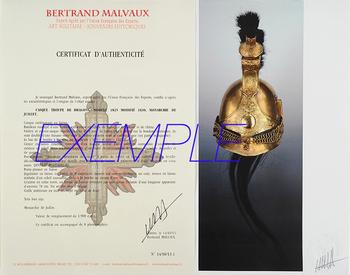
Next update Friday, december 26 at 13:30 PM
FOR ALL PURCHASES, PAYMENT IN MULTIPLE CHECKS POSSIBLE
bertrand.malvaux@wanadoo.fr 06 07 75 74 63
SHIPPING COSTS
Shipping costs are calculated only once per order for one or more items, all shipments are sent via registered mail, as this is the only way to have proof of dispatch and receipt.
For parcels whose value cannot be insured by the Post, shipments are entrusted to DHL or Fedex with real value insured, the service is of high quality but the cost is higher.
RETURN POLICY
Items can be returned within 8 days of receipt. They must be returned by registered mail at the sender's expense, in their original packaging, and in their original condition.
AUTHENTICITY
The selection of items offered on this site allows me to guarantee the authenticity of each piece described here, all items offered are guaranteed to be period and authentic, unless otherwise noted or restricted in the description.
An authenticity certificate of the item including the description published on the site, the period, the sale price, accompanied by one or more color photographs is automatically provided for any item priced over 130 euros. Below this price, each certificate is charged 5 euros.
Only items sold by me are subject to an authenticity certificate, I do not provide any expert reports for items sold by third parties (colleagues or collectors).
FOR ALL PURCHASES, PAYMENT IN MULTIPLE CHECKS POSSIBLE
bertrand.malvaux@wanadoo.fr 06 07 75 74 63
An authenticity certificate of the item including the description published on the site, the period, the sale price, accompanied by one or more color photographs is automatically provided for any item priced over 130 euros. Below this price, each certificate is charged 5 euros.
Only items sold by me are subject to an authenticity certificate, I do not provide any expert reports for items sold by third parties (colleagues or collectors).

